
Bollington is a town and civil parish in Cheshire, England, to the east of Prestbury. In the Middle Ages, it was part of the Earl of Chester's manor of Macclesfield and the ancient parish of Prestbury. In 2011, it had a population of 8,310.

The Hackensack River is a river, approximately 45 miles (72 km) long, in the U.S. states of New York and New Jersey, emptying into Newark Bay, a back chamber of New York Harbor. The watershed of the river includes part of the suburban area outside New York City just west of the lower Hudson River, which it roughly parallels, separated from it by the New Jersey Palisades. It also flows through and drains the New Jersey Meadowlands. The lower river, which is navigable as far as the city of Hackensack, is heavily industrialized and forms a commercial extension of Newark Bay. Once believed to be among the most polluted watercourses in the United States, it staged a modest revival by the late 2000s.

Macclesfield was, from 1974 to 2009, a local government district with borough status in Cheshire, England. It included the towns of Bollington, Knutsford, Macclesfield and Wilmslow and within its wider area the villages and hamlets of Adlington, Disley, Gawsworth, Kerridge, Pott Shrigley, Poynton, Prestbury, Rainow, Styal, Sutton and Tytherington.

Kerridge is a village in Cheshire, England, part of the parish of Bollington. Kerridge borders the neighbouring parish of Rainow.

The River Blakewater is a river running through Lancashire, giving its name to the town of Blackburn.
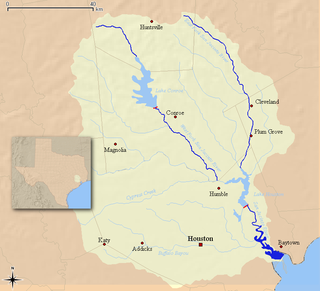
The San Jacinto River flows through southeast Texas. It is named after Saint Hyacinth. In the past, it was home to the Karankawa and Akokisa tribes.

Macclesfield is a constituency currently represented in the House of Commons of the UK Parliament since 2010 by David Rutley, a Conservative.

Rainow is a village and civil parish in Cheshire, England, in the valley of the River Dean and next to the B5470 road between Macclesfield and Kettleshulme. It straddles the eastern side of the Peak District border of Derbyshire and Cheshire, and is surrounded by pasture farmland. The Peak District Boundary Walk runs past the village. The village's name comes from the Old English Hraefn Hoe, meaning Ravens' Hill. It is a former coal-mining village and has a population of around 2,500.

Big Run is a 4.4-mile-long (7.1 km) tributary stream of the South Branch Potomac River, belonging to the Potomac River and Chesapeake Bay watersheds. Big Run flows through the city of Romney and the campus of the West Virginia Schools for the Deaf and Blind in Hampshire County, West Virginia. The stream is known by local residents as Town Run and Town Creek.
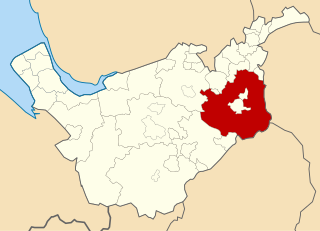
Macclesfield Rural District was a rural district of Cheshire, England from 1894 to 1974.
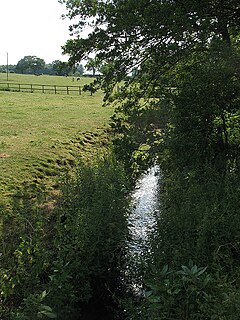
The River Croco is a small river in Cheshire in England. It starts as lowland field drainage west of Congleton, flows along the south edge of Holmes Chapel, and joins the River Dane at Middlewich. It is about 8 miles (13 km) long.
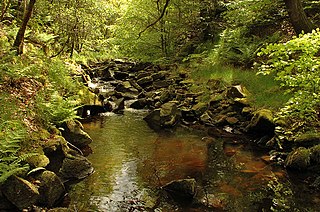
The River Roddlesworth is a river in Lancashire, England, a tributary of the River Darwen.
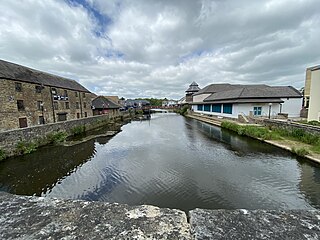
The River Cleddau consists of the Eastern and Western Cleddau rivers in Pembrokeshire, west Wales. They unite to form the Daugleddau estuary and the important harbour of Milford Haven.

The Quaboag River is a 25.7-mile-long (41.4 km) river in Massachusetts that heads at Quaboag Pond in Brookfield at an elevation of 594 feet (181 m) above sea level. It flows west to the village of Three Rivers, Massachusetts, at an elevation of 290 feet (88 m).
Ingersley Hall, later Savio House, stands to the east of the town of Bollington, Cheshire, England. The house was built in about 1775 for John Gaskell. Extensions were added to it in 1833 for John Upton Gaskell. The house was sold by the Gaskell family in 1933. In the 1950s it was taken over by a religious order, the Salesians of Don Bosco, and renamed Savio House. As of 2011 the house is used as a retreat and activities centre for young people. The front of the house is constructed in ashlar, with the remainder in coursed sandstone rubble. The house is roofed in Welsh slate and has stone chimneys. It has a rectangular plan and is in two storeys. The architectural style is Greek Revival. The north front is symmetrical with five bays divided by pilasters. The porch is in Doric style. The west front has eight bays, the central three of which were in the original house. All the windows in the north and west fronts are sashes with 12 panes. The south door is in Tuscan style, and was probably moved from the west front. The house is recorded in the National Heritage List for England as a designated Grade II listed building. Also listed at Grade II is a former coach house to the south of the hall, built in about 1850, and converted into a conference hall in about 1950.

Clarence Mill is a five-storey former cotton spinning mill in Bollington, Cheshire, in England. It was built between 1834 and 1877 for the Swindells family of Bollington. It was built alongside the Macclesfield Canal, which opened in 1831.

Bollington is a civil parish in Cheshire East, England. It contains 66 listed buildings that are recorded in the National Heritage List for England, all of which are at Grade II. This grade is the lowest of the three gradings given to listed buildings and is applied to "buildings of national importance and special interest". In the parish is the town of Bollington, which is surrounded by countryside leading up to the foothills of the Pennines on the east. To the south of the town is the long Kerridge Hill, which has been a source of industry, with coal mining on its east side and quarrying on the west side. These quarries are the source of Kerridge stone-slate, which is used to roof many of the houses in the locality.
Rainow is a civil parish in Cheshire East, England. It contains 69 buildings that are recorded in the National Heritage List for England as designated listed buildings. Of these, three are listed at Grade II*, the middle grade, and the others are at Grade II. Apart from the village of Rainow, the parish is now rural, although in the past there has been industry in the form of small mills. One of the listed buildings is a former water mill, but most are country houses and associated structures, smaller houses and cottages, and farmhouses with farm buildings. Otherwise the listed buildings are milestones, mile posts, boundary stones, weirs, a bridge, a folly, stocks, and two churches.

The North Cheshire Way is a 71-mile (114 km) long-distance footpath in Cheshire, England. It runs approximately eastwards from Hooton railway station on the Wirral peninsula to Disley railway station on the edge of the Peak District, where it connects with the Gritstone Trail. There is a 6-mile (9.7 km) spur from Chester to Croughton.
















